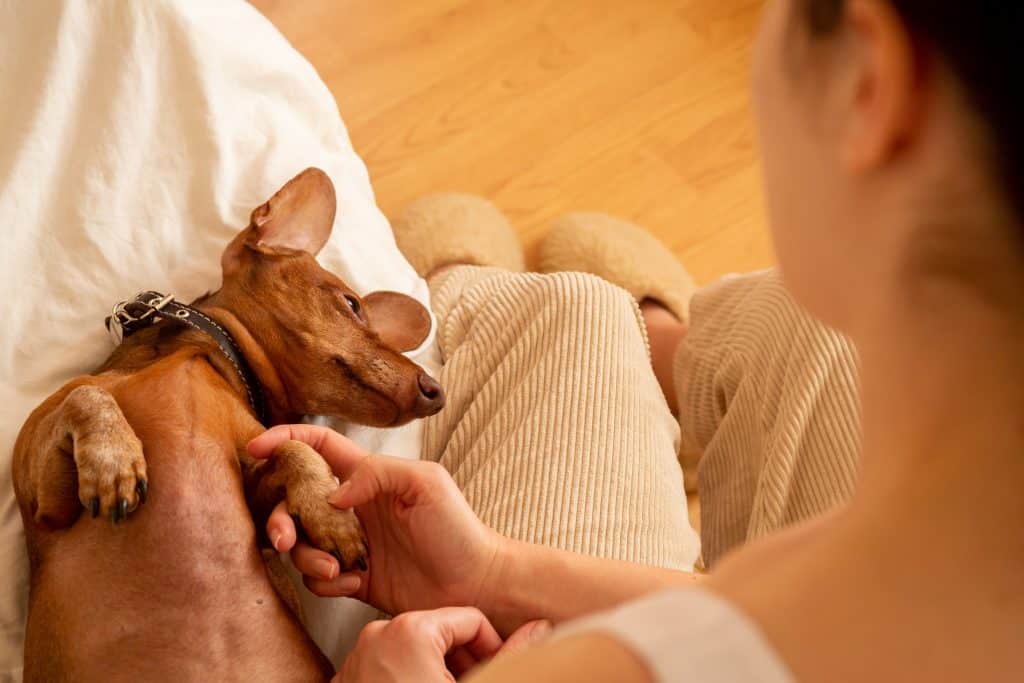
We all love our dogs and want to give them everything we can to make them happy. However, our waiting hand and paw on our pets can become detrimental to our dogs behaviour without us even being aware. In this blog Jemma talks about dog boundaries and why they are important to our dogs training.
How well has your dog trained you?
People usually laugh when we ask them this question, but dogs are super smart and do things that reward them. Unfortunately, we as humans aren’t always savvy to the fact that we are being trained.
Start by asking yourself how many times a day does my dog ask me to do something that I instantly comply with? These can be all sorts of things like repeatedly asking to go outside, instigating play by dropping a toy on you or similar, stealing items to get you to come get them, barking or physically touching you until you touch them and many more.

Most of the time we as owners are totally unaware of all these little moments every day and slowly over time the roles quickly change on who is training who. When our dogs learn that their behaviour can get what they want from us these behaviours can often escalate when we don’t carry out the behaviour as promptly as our furry friend requests.
For example you are working from home and your dog will at various points come over and demand your attention by resting its head on your lap. Most days you absentmindedly give the your dog an ear scratch or fuss whilst you get on with your work. No big deal right? The next day you have a big meeting and are presenting but your dog comes over and does the same thing. You are busy so just brush the dogs head off your lap and ask them to lie down.
Obviously, the dog is confused as this is not the normal drill. The dog tries again, and you push them away again. Frustrated the dog now decides to up its game and barks at you. Obviously, you can’t have that during your meeting, so you toss the dog a chew to keep them occupied. Brilliant the dog thinks, barking is even better than the resting of my head as that results in a chew.
The next day the dog goes straight to barking. As that resulted in a higher reward. The confused owner wonders what on earth is the matter with their suddenly vocal dog. So reassures the dog and gives them a fuss. Thus, the dog is rewarded for the barking behaviour. And without the owner even being fully aware of this. Before you know it you have an attention seeking dog that will vocalise for attention. If this is not dealt with correctly the problem will persist.
This is a very specific example but can be applied to all sorts of scenarios.

What we tend to see when the dog becomes the trainer of the unknowing owner, is that we start to see a breakdown in the relationship. Other things will start to rear their head like the ignoring of commands and just generally the dog taking a more leadership role in the partnership which can precipitate other issues like reactivity.
What’s the answer to dog boundary setting?
Take a step back and assess your interactions with your dog. Does your dog instigate these interactions? We are by no means saying not to interact with your dog. But to try and make them more balanced in your favour. You start the interactions, and they are not at your dog’s request.

Does your dog generally listen to you? Or is it more a pick and choose when to listen as it suits them? We should set clear boundaries for our dogs so they know the “rules”. Now I’m not talking about making your home a dictatorship. It is important we remember that our dogs are dogs and not people. (not matter how much we love them). When we start treating our dogs like humans that is usually when issues can begin. Just like you set boundaries for your children you need to set boundaries for your dog. Trust me your relationship with your dog is likely to be stronger when the dog knows the boundaries. It is also likely your dog will be more relaxed as result.
It is important if we set boundaries, we are consistent with them. If we enforce boundaries one day. And fail to the next. Then choose to enforce them again this can cause confusion and frustration in the dog. The opposite of what we are trying to achieve. Everyone must know the rules, so the dog isn’t confused.
People often ask what boundaries they should put in place. We tell them it is very much personal preference and very much dog and person specific.
However, there are a few that I would always want. Such as doorway manners, not jumping up, not stealing, basic manners and not encouraging attention seeking. The rest is up to you – do you want to allow your dog on the sofa? Thats fine but make sure that you have rules in place around it. Such as if you ask the dog to get down it does without question. If this is not the case, I would be rethinking the sofa rule.

Take some time to think about what boundaries your dog has. See if there are any you think could be clearer to your dog.
If you would like some help looking at your dogs boundaries to rebalance your relationship, then get in touch today.
